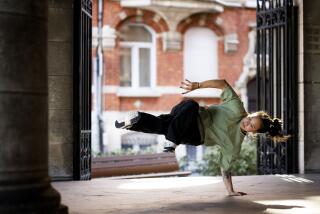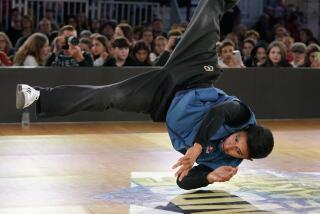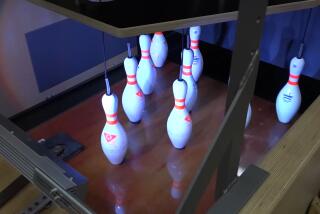A Smashing Comeback : Sports: Badminton’s status is on the rise--from a back-yard game to the big time. But it’s always had its devotees.
- Share via
When one-upmanship is practiced in the world of racket sports, the game of badminton doesn’t have a chance. It lacks the popularity and purse strings of tennis and racquetball, while its claim to the blue-blood breeding of squash doesn’t have quite the same scope.
But expect no apologies from Southlanders who have long been wise to the wonders of badminton. And now, with the sport’s newly appointed designation as a full-medal game at the 1992 Barcelona Olympics--a springboard leap from its demonstration status at the 1988 Seoul Games--badminton players maintain with unqualified assurance that their time has finally come.
“It has a back-yard image,” says Ginny Hales, a member of the board of directors of the Southern California Badminton Assn.
“That is our biggest problem in the United States. From being played in the back yard on picnics for so long, people can’t disconnect from that image and switch to the indoor game, which is fast and furious and really fun.”
Hales, a lifetime player and coach who has been working on a grant through the Amateur Athletic Foundation of Los Angeles to set up junior programs for the last four years, says, “I think as far as the United States goes, the field is wide open. I think if anyone with good athletic ability takes up badminton, they can go to the top and travel the world very, very fast.”
For now, though, the top of the world belongs to China, Korea, Indonesia, Denmark, Sweden, England and Malaysia where badminton is “big time.” In those countries, televised badminton championships are sold out to as many as 17,000 spectators, and it is not unusual for local newspaper pages to be consumed with daily coverage of badminton events.
But in the United States, badminton has long been beleaguered by misconceptions and neglect. Except for a few enclaves, such as Arizona State University and the Manhattan Beach Badminton Club, as well as a network of smaller clubs scattered along both the East and West coasts, badminton has gone unnoticed.
To badminton aficionados, the only thing lightweight about competition is the 3 1/2-ounce racket and the shuttlecock, or “bird.”
The shuttlecock’s 16 feathers, set into a basecork, are capable of coming off the racket at speeds of more than 100 m.p.h. on a hard smash. Upon clearing the net, shuttlecocks flair and drop. This gives the skilled badminton player the leverage of moving an opponent back and forth. Unlike tennis players who can stand and hit from the baseline, badminton players never rest.
The fun begins at any age. Calling for strong wrist movement, basic strokes are easily acquired. As rallies lengthen--sometimes rising as high as 40 shots a point in the upper levels of play--the technique for hitting the bird faster necessarily becomes more advanced.
For Stan Hales (Ginny Hales’ brother-in-law), a Pomona College mathematics professor and former badminton champion, the challenge began at 12 when he abandoned tennis.
“In this game everything is on the fly. And you get to leap, and lunge and slug to the bird, and it is just so much faster and more exciting than other games. The stamina required is much greater,” he says.
Not shy about blowing his sport’s horn, Hales, 48, decided a few years ago to prove his point.
In comparing the 1985 Wimbledon Tennis Final with the World Badminton Championship at Calgary that same year, he gathered these facts: “During the three-hour and 18-minute tennis final, the ball was actually in play for 18 minutes; in the badminton final the match lasted 76 minutes with the shuttle in play for 37 minutes, or twice as long for a match that lasted a third as long. The average number of shots a rally at Wimbledon was 3 1/2, while the number of shots a rally at the badminton final was 13 1/2.”
Hales, who maintains that his pulse rate of 38 per minute and blood pressure of about 100 over 50 are direct responses to the badminton exercise he gets, says, “The tennis players traveled about two miles during their match, while the badminton players ran about four.”
Hales’ wife, Diane, head badminton coach for a youth group funded by the Amateur Athletic Foundation and a badminton instructor at Citrus College, also has done her share to promote the sport.
Standing at 4-feet-11, Diane Hales (with a trace of satisfaction in her voice) recalls the time she gave Seattle Seahawks quarterback Jim Zorn a lesson in the subtlety and deception involved in controlling the bird.
“He had a lot of power. So he could smash it. But I was just standing there, running him from corner to corner, purposely making him find out how big the court could really get,” she says.
After the workout, she asked if Zorn was ready for another. He replied, she says: “I think I need a break.”
Strategy is also a factor in winning, says Diane Hales, whose competitive years in the 1970sbrought her four national titles. “You run your opponent around in singles. Then put it away when he gets off balance.”
“Forcing your opponent to hit up so you can return with a smash” is the plan of doubles. “There is a lot of smashing in doubles,” she says.
Badminton was a “high society and tea-time” pastime confined largely to the Eastern United States when socialite Lyle Mahan took off his tuxedo jacket at the Badminton Club of New York in 1905.
By realizing the freedom to sprint, he precipitated badminton’s spread across America, according to Diane Hales’ research for a master’s thesis on the history of the sport.
Badminton’s apex of growth came during the ‘30s when many Hollywood movie stars played. Following the loss of key players, facilities and equipment to the war effort, the “fastest growing sport in America” never regained its momentum.
Not since the late 1940s and ‘50s have American badminton players been able to stand up to the rest of the world in international competition. The men’s team in this country was one of the top three in the world. The women’s team held the world championship from 1957 through 1966.
Would they enjoy such success today?
“It is not so much that our standards have dropped,” says Stan Hales. “It is that the world’s standard has gone way up as the game became more professional.”
China is responsible for catapulting badminton to the performance level its athletes aspire towards today, says Stan Hales, the coach of the American team that played in China in 1987.
In China, children of 8 and 9 are singled out and tested for speed, fast reflexes and endurance. Four years later, those with the most potential are sent to Beijing for intensive training. Their quickness, pace and unbelievable stamina leave American players hopelessly outclassed.
The rare American badminton player often receives the “red carpet” treatment in numerous badminton-playing countries, says Cassandra Salapatas-Metz of Tarzana.
“It is such a popular sport all over the world that when a U.S. player goes to a foreign country he (or she) becomes almost like a big celebrity.”
Typical was the time she and her husband, Dennis, a marketing account executive for the Forum, were honeymooning in Bermuda.
“My husband had picked up a sweater in England that said ‘Wimbledon Badminton Club.’ We knew that because Bermuda was English, there was bound to be someone who played badminton. He put his sweater on and we went into the department stores. By the second department store, we met a gentleman who ran the Bermuda Badminton Club. He invited us to come out. It really made it fun for us,” she said.
The knowledge that they can telephone the National Badminton Assn. anywhere in the world has usually meant an invitation to someone’s house and sometimes a place to stay, says Salapatas-Metz.
Closer to home, the discovery of celebrityhood at the Olympic Sport’s Festival in Oklahoma last summer was very special to Joy Kitzmiller, 26, a high school math teacher from Manhattan Beach.
For the Stanford graduate, the memory of organizing a team that brought home a national title hasn’t entirely faded.
“The crowd was really electric. They really enjoyed the game,” says Kitzmiller of the crowd of more than 2,000 who watched her win a gold medal in singles play. The event, involving 34 players, marked badminton’s debut on the Olympic Sport’s Festival agenda.
Says Kitzmiller, a lithe, graceful athlete who will leave shortly for Austria to participate in the Uber-Thomas Cup Team Championships (badminton’s equivalent of tennis’ Davis Cup Team): “Before, it was more of a touch game. I play more of a power game now. I’ve gotten stronger and I’m hitting harder. It had to come to that. Because that is the way the game is now.”
THE TIP-OFF
Chris Kinard, named seven times the U.S. No. 1 Men’s Singles Player, offers these tips to beginning badminton players:
* Use the “shake-hands” grip (similar to the Eastern grip in tennis). Avoid the “frying-pan” grip (similar to the Western, top-spin, forehand in tennis), which restricts wrist action.
* Learn to start a rally by hitting the bird underhand, as it would be hit on the deep serve. Drop the bird in front of you and hit it with an upward and forward sweep of the racket as it nears the floor.
* After the serve, badminton is primarily an overhead game. Learn to hit a “clear” (a high shot that reaches its maximum height above the base line of your opponent) from your base line to the opponent’s base line. You’ll have to be sure you are behind the bird, that you hit it with a full-arm extension overhead, that you meet the bird with a flat racket face, and that your weight goes into your swing.
* After you can hit base line to base line, try drop shots at the net (and from farther back by using a slicing motion similar to that of the slice serve in tennis).
* Try to meet any bird hit short at as high a point as you can; meet as near the top of the net as you can any drop shot hit close to the net.
* Remember that because of the lighter racket and the remarkable control of the bird that can be developed, badminton involves much more deception than tennis. Learn to hold your shots to the last fraction of a second before execution; when your opponent is hitting, don’t move too soon or you will invariably be “faked out.”
* Badminton is a tough game. You have to work at it. It’s also a great game, so go to it!
More to Read
Go beyond the scoreboard
Get the latest on L.A.'s teams in the daily Sports Report newsletter.
You may occasionally receive promotional content from the Los Angeles Times.










